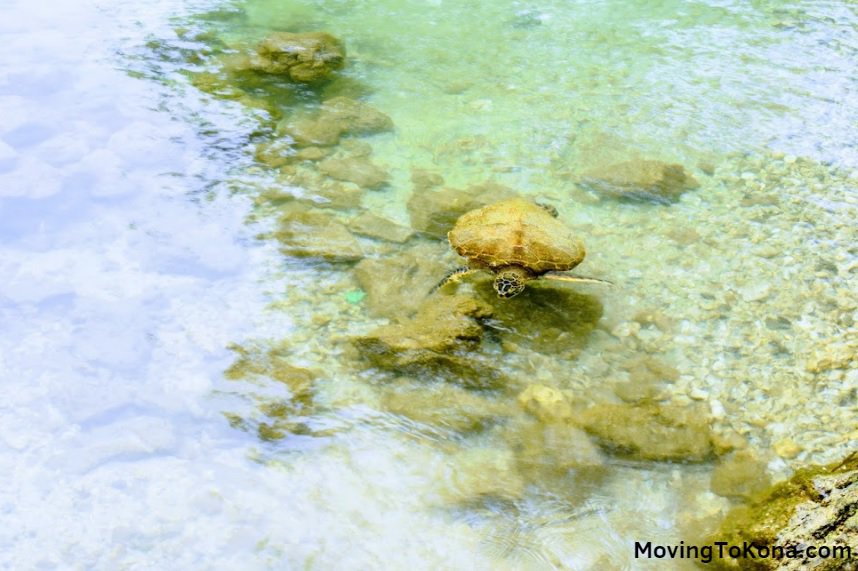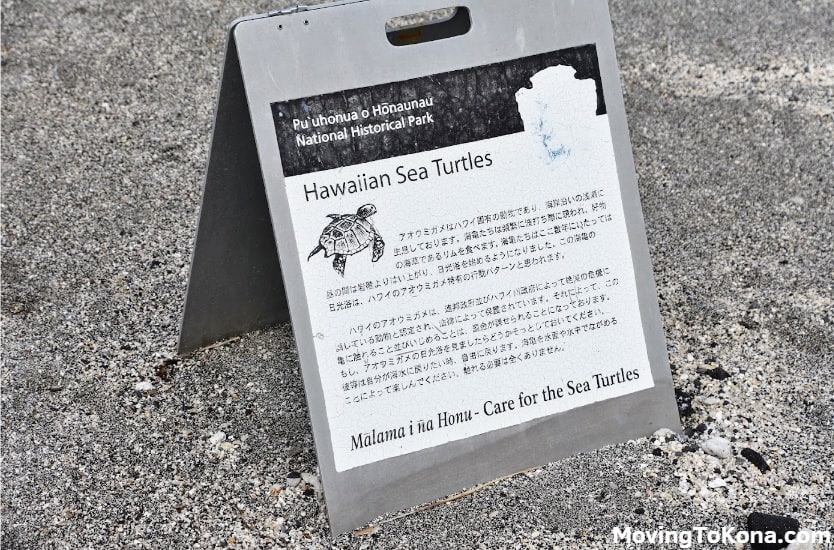Can I Touch a Sea Turtle in Hawaii?

What Species of Sea Turtle Can Be Found in Hawaii?
Hawaii is home to five of the seven species of sea turtles in the world, including the green sea turtle (honu), hawksbill (honu’ea), leatherback, loggerhead, and olive ridley. The green sea turtle is the most commonly encountered sea turtle in Hawaiian waters and is easily identified by its large, 4-5 feet long shell and 250-pound weight, although it can grow as large as 500 pounds. Despite its name, the green sea turtle does not appear green from the outside, but is instead called “green” due to its green-colored internal fat tissue, caused by its algae-based diet. They are often seen basking on beaches, resting under underwater ledges, and nibbling on algae in shallow waters. Male green sea turtles have a longer, thicker tail and claws on each flipper, which is used for mating. The hawksbill is the second most common sea turtle species in Hawaii.

Is it Safe to Touch a Sea Turtle in Hawaii?
Absolutely not! In Hawaii, sea turtles are federally and state protected creatures that are even considered sacred to traditional Hawaiians, who believe them to be ‘aumakua, or ancestral guardian spirits. As such, it is not only illegal to touch sea turtles, but it is also disrespectful and harmful to the animals.
Disturbing sea turtles can cause changes to their feeding and mating habits and can also lead to the animals being injured or even killed. Despite this, too often we see visitors and locals alike snapping pictures of themselves touching or riding sea turtles at popular spots such as Laniakea Beach and Ali’i Beach on the North Shore of Oahu.
It is important to remember that the best way to view these amazing creatures is from a distance. Bring binoculars along on viewing excursions and observe the turtles from at least 100 yards away if they are humpback whales, or at least 50 yards away if they are other marine mammals, dolphins, other whale species, or Hawaiian monk seals. Do not attempt to touch, ride, or feed turtles and do not encircle or trap them between boats or shore. If approached by a marine mammal or turtle while on a boat, put the engine in neutral and allow the animal to pass.
If you see a turtle in danger, call the Department of Land and Natural Resources at 808-587-0077. Remember, we all have a responsibility to respect and protect these animals, so do your part and help keep them safe.
Is it Legal to Touch a Sea Turtle in Hawaii?
No, it is not legal to touch a sea turtle in Hawaii. According to the federal Endangered Species Act, the violation of this law can result in hefty monetary penalty or imprisonment. Moreover, touching a sea turtle is not only harmful to the creatures, but it is also disrespectful to the Hawaiian people, as sea turtles are considered sacred and are seen as ‘aumakua, a kind of ancestral guardian spirit.
What is the Best Way to View Sea Turtles in Hawaii?
The best way to view sea turtles in Hawaii is to visit Turtle Beach in Oahu (also known as Laniakea Beach). Before visiting, it is important to review the guidelines on how to act around this endangered species. You should stay at least 15 feet away from the sea turtles and avoid touching them. You should also avoid making loud noises or chasing them and turn off the flash when taking pictures. Additionally, the summer months and midday hours (11 am to 3 pm) are the best time to see Hawaii sea turtles since they prefer calmer waters and bask in the heat of the day.
You can also take a turtle tour in Maui, which allows you to snorkel, sail, or kayak amongst the sea turtles. Popular sites to view sea turtles include Honolua Bay, Ka’anapali Beach’s Puu Kekaa, Kapalua Bay, Keawakapu Beach, Makana Landing, Maluaka Beach, and Ulua Beach. If you are swimming or snorkeling in the ocean and the sea turtles come close to you, keep your hands still and move slowly.
Turtle Bay on the north shore of Oahu is also a great place for whale spotting in season and seeing Hawaiian Green Sea Turtles in their natural habitat. This area is surrounded by 5 miles of beaches and 12 miles of trails, making it a great place to explore.
What are the Consequences for Harassing Sea Turtles in Hawaii?
Harassing sea turtles in Hawaii is a serious offense and carries significant penalties. According to the Endangered Species Act and state authorities, it is illegal to touch, capture, kill, or harass a sea turtle. Violators can face steep fines of up to $25,000 and even prison time of up to one year.
In addition to criminal and civil penalties, violators may be subject to public humiliation and reprimand, as was the case with a man on vacation in Hawaii who was fined $1,500 for harassing a sea turtle and posting the act on social media. There may also be additional consequences such as having to pay for the damages incurred by the violator, such as the costs associated with searching for and treating injured wildlife.
Overall, it is important to remember that harassment of sea turtles is a serious offense, and will not be tolerated in Hawaii. Individuals should respect and obey the laws and regulations surrounding sea turtles, or face the consequences.
What Should I Do if I See a Sea Turtle in Hawaii?
If you are lucky enough to see a sea turtle in Hawaii, there are a few important steps to remember to ensure that you are respecting the turtle’s space and not disturbing it.
- Remain at least 15 feet away from the turtle, and do not block its access to or from the ocean.
- Do not touch the sea turtle. It is illegal to touch sea turtles.
- Do not harass the sea turtle. Do not chase it, swim directly at it, make loud noises in its presence, or feed it.
- When taking photos, make sure flash is off. Using a GoPro is recommended.
- Do not encircle or trap the turtle between boats or shore.
- If the turtle approaches your boat, put the engine in neutral and allow the animal to pass.
- Limit your viewing time of the turtle to around 30 minutes.
Remember, the green sea turtle is an endangered species in Hawaii, and any stress to the turtle can endanger the species. It is important to be mindful and respectful of these majestic creatures.
Where in Hawaii Can I Find Sea Turtles?
Sea turtles can be found in the waters off the coast of Hawaii. Five of the world’s seven species of sea turtles call these waters home, including the green sea turtle (honu), hawksbill (honu’ea), leatherback, loggerhead, and olive ridley. On Maui, sea turtles are a favorite discovery of snorkelers and divers on the island’s South and West coastlines. For those looking to observe sea turtles in their natural habitat, Turtle Bay on the northshore of Oahu is one of the last undeveloped areas and is recognized for its rock formations, wild coastal beaches, threatened green sea turtles, endangered Hawaiian Monk Seal habitats, whale spottings in season, traditional fishing areas, small local agricultural lots, and Hawaiian ancestral burial grounds. Sea Life Park, located just 15 miles from Waikiki on Oahu’s Makapuu Point, also offers an up-close look at sea turtles in its touch pool, as well as regular turtle feedings and interactive adventures.
How Can I Help Protect Sea Turtles in Hawaii?
- Keep your distance – Stay at least 10 feet away from honu and honuʻea, and don’t block their access to or from the ocean.
- Don’t touch – It is illegal to touch sea turtles, so resist the urge.
- Avoid harassment – Don’t chase them, swim directly at them, make loud noises in their presence, or feed them.
- Don’t use flash photography – When snapping photos, make sure flash is off. We recommend using a GoPro.
- Reduce your use of single-use plastics – Single-use plastics like straws, cutlery, and takeout containers can be deadly for sea turtles if ingested.
- Reduce your use of chemicals – Harsh chemicals, including chemical sunscreen, kill the coral reef, which provides food for green sea turtles.
- Respect coastal development – Coastal development along Hawaii’s coastline threatens to reduce the amount of suitable beach area for turtle nesting and basking.
- Participate in beach clean-ups – Removing trash, fishing line, and nets help protect sea turtles from entanglement.
- Educate yourself – Learn more about the green sea turtle and other marine species at NOAA’s Sea Turtle page or Hawaii Hawksbills.
- Spread the word – Share your knowledge with friends and family and encourage them to also help protect sea turtles in Hawaii.
Are There Any Risks to Swimming with Sea Turtles in Hawaii?
Are there any risks to swimming with sea turtles in Hawaii? Swimming with sea turtles can be a magical experience but it is important to be aware of the risks. While it is legal to observe sea turtles from a distance, it is illegal to touch or disturb them. Hawaii has enacted strict regulations to protect the endangered green sea turtle species from human interaction. It is important to stay at least 6 to 10 feet away from sea turtles, as any sudden movements or stress can endanger the species. Additionally, touching or harassing turtles may also transmit illnesses from you to them and vice versa. To ensure a safe and enjoyable experience when snorkeling, it is also advisable to be aware of the waves, wind, and weather conditions of the diving spot. Lastly, when in the water, be respectful to other wildlife and give them the space they need.

